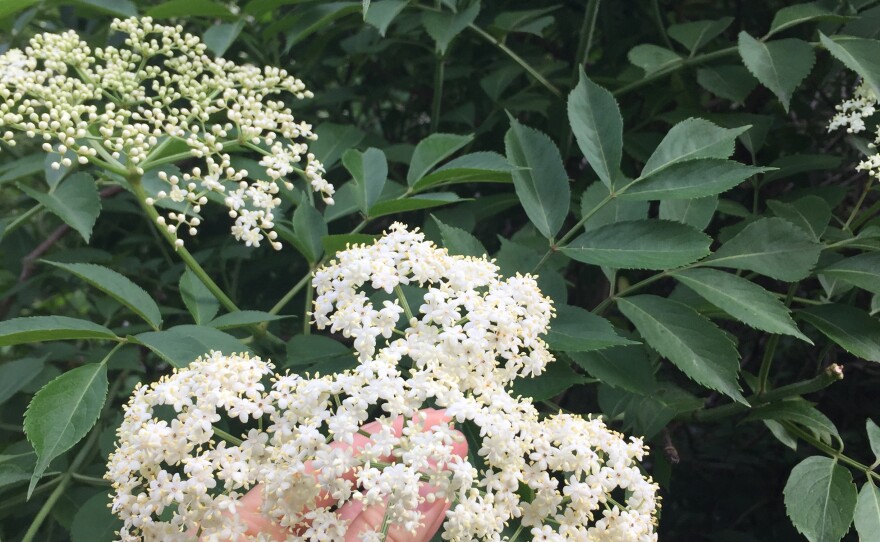There are many different sambucus, Constanza Leal explains. There’s sambucus nigra and caladiensis. She points them out as she names them for me.
Constanza works as a forager both in Colombia where she spends her winters and for a local restaurant in Wellfleet. We’re standing in a wet, sunny area where we’ve spotted elderberry plants on the side of the road.
“Elder is such a magical plant and food because it really, it has been known for so long as the people’s medicine. There’s medicine in the berries, there’s medicine in the fruit and the bark, the leaves, the stems.”
There’s also medicine—and food and drink—in the flowers. The fragrant buttery white flowers are umbel flowers—like Queen Anne’s lace, only much bigger and on a shrub. When elderberry flowers in late June it marks the easiest time of year to identify the plant.
“Very delicate, always it’s going to be white in color except further north where sometimes you can find a type of elderberry that’s actually has a pinkish purple flower. But the one that we get here in New England very generous white beautiful clusters of flowers,” Constanza says.
The flowers are incredibly aromatic and are often used in drinks. If you’ve ever tasted Saint Germain on its own or in a cocktail, this is an elderflower liqueur—you can make it by steeping freshly picked elderflowers in vodka and adding sugar. But there are all kinds of other non-alcoholic drinks you can make with elderflower too.
“One year I foraged a bunch of elder and I made some really beautiful wild sodas that were very bubbly it’s like a floral champagne if you will and it was one of the most fun experiences to just in such a short period of time to make such a fun sparkling beverage with the wild yeast that’s found naturally on the flowers.”
Elderflowers have yeast in their pollen and it’s so abundant that it ferments elderflower soda quickly, before all the sugars are consumed and the drink becomes alcoholic. This makes it a fun wild drink to make and try with kids. The flavor of elderflowers in drinks is hard to describe—it’s floral but not like lavender or rose—more like a jasmine scented grapefruit only sweeter and muskier. You can also eat elderberry flowers—in many European cuisines they’re served lightly battered and fried. Constanza says this elderflower tempura is excellent.
“Uh it is so delicate, it’s not particularly strong in flavor but it’s just delicious because you’re really just enjoying the blossoms with the tempura so you can put that on anything. I mean think of if you were to have ice cream with maybe fried dough, which I wouldn’t, but I would definitely have it with elderflower tempura.”
In both the elderflower tempura and the drinks, you want to avoid eating the elderflower stems—they can cause digestive problems, so you’re supposed to snip them off, and only take the blossoms. Constanza also cautions that although she loves working with elderflowers, she tries to pick them sparingly—after all, later in the summer, they become elderberries.
—
Constanza is a forager for Ceraldi restaurant in Wellfleet.
Here are links to the recipes mentioned in the piece:









